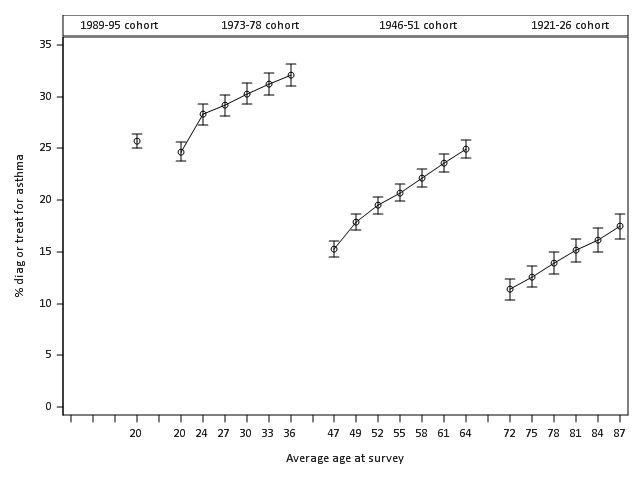By: Professor Julie Byles
We don’t usually think of asthma as a condition that affects older people. However asthma can develop at any time across the life course, and prevalence increases with age. Asthma can also be difficult to differentiate from chronic obstructive pulmonary disease, and these two conditions can be comorbid. Data from the Australian Longitudinal Study on Women’s Health (also known as Women’s Health Australia) show how rates of asthma are increasing with age, and across the generations.

Source: Byles J, Hockey R, McLaughlin D, Dobson A, Brown W, Loxton D, Mishra G. Chronic conditions, physical function and health care use: Findings from the Australian Longitudinal Study on Women’s Health.
Report to the Australian Government Department of Health. June 2015
For over 20 years, Women’s Health Australia has surveyed four generations of women on their health and wellbeing. As the women in the study aged, the overall prevalence of asthma has increased. Initially, asthma rates were much lower in older women than younger women, with around 1 in 10 women (10%) in their 70s (born 1921-26) reporting a diagnosis compared to 1 in 4 women (26%) in their early 20s (born 1973-78 and 1989-96). Prevalence of asthma increased in all cohorts over time and as the women aged, suggesting that there will be an increasing burden of asthma among future generations of older women. To some extent this increase in asthma may be due to better asthma awareness, diagnosis and treatment, but it is also likely to reflect a true increase in prevalence of this condition.
The rise in asthma prevalence is concerning, firstly due to the effect on quality of life. Women with asthma also have lower physical function and mental health scores across their life, and reported more back pain. Asthma is also more common among women who are economically disadvantaged, with asthma affecting of their ability to work.[1] Additionally, older women with asthma have a higher risk of hospitalisation.[2]
Asthma management among younger people has improved considerably, with reductions in asthma deaths. However, among older people, there has been little improvement in mortality rates for people with asthma. Research using Women’s Health Australia data show that older women with asthma have a 17% higher risk of death than women without asthma, even when other mortality risk factors are taken into account.[3] As the population ages, it is predicted that the death rate from asthma will continue to rise substantially.This increased mortality risk for older women with asthma highlights the need to improve medical monitoring for these women.
The management of asthma in older people can be complicated by physical disability and by comorbid conditions such as heart disease, hypertension, thrombosis, bronchitis/emphysema, osteoporosis, and cognitive decline. Multiple medicines for these conditions also increase the risk of drug interactions and adverse effects. Women with asthma therefore need careful monitoring of asthma severity, medication effectiveness, and a comprehensive approach to the management of comorbid conditions.[4]
In Australia, women can use the Annual Asthma Cycle of Care (AACC) which involves a set of government subsidised general practice consultations. The initiative provides for those with moderate to severe asthma to have their clinical condition assessed, their medications reviewed, and to develop a written asthma management plan. They can also have a subsidised consultation for Chronic Disease Management (CDM), which similarly allows for assessment and management of chronic and comorbid conditions. Among the oldest cohort of women in ALSWH (born 1921-26), around 45% of women with asthma had AACC or CDM when aged in their 90’s. In contrast, only 35% of women with asthma from the 1946-51 cohort (aged around 67 years), and 10% of women with asthma in the 1973-78 cohort (aged around 40) had a record of having either of these two services.[5] Further investigation into the barriers to using these services, and other concerns and needs of women with asthma is needed.
The research on which this article is based was conducted as part of the Australian Longitudinal Study on Women’s Health (also known as Women’s Health Australia) by the University of Queensland and the University of Newcastle. The Australian Longitudinal Study on Women’s Health is a large population based prospective study of four cohorts of Australian women born 1989-95, 1973-78, 1946-51, 1921-26. More information on the study is available at www.alswh.org.au
We are grateful to the Australian Government Department of Health for funding and to the women who provided the survey data.
[1]Majeed T, Forder P, Mishra G, Byles J. Women, work and illness: A longitudinal analysis of workforce participation patterns for women beyond middle age. Journal of Women’s Health. 2015; 24(6): 455-465.
[2] Harris ML, Dolja-Gore X, Kendig H, Byles JE. First incident hospitalisation for Australian women aged 70 and beyond: a 10 year examination using competing risks. Archives of Gerontology and Geriatrics, 2016; 64: 29-37.
[3] Eftekhari P, Forder PM, Majeed T, Byles JE. Impact of asthma on mortality in older women: an Australian cohort study of 10413 women. Respiratory Medicine, 2016; 119: 102-8.
[4]Byles JE. How do the psychosocial consequences of ageing affect asthma management? Medical Journal of Australia, 2005;183(1):S30-S32.
[5]Byles J, Mishra G, Hockey R, Adane A, Chan H, Dolja-Gore X, Forder P, Harris M, Majeed T, Loxton D and Tooth L. Use, access to, and impact of Medicare services for Australian women: Findings from the Australian Longitudinal Study on Women’s Health. Australian Government Department of Health. June 2017.
Professor Julie Byles
Director of the Australian Longitudinal Study on Women’s Health, and Head of ILC-Australia
Professor Julie Byles is a Director of the Australian Longitudinal Study on Women’s Health, and Head of ILC-Australia.
